We get that you’re busy, so in short: Eligible contractors have to install the equipment, then apply for the rebate.
At UniColorado, the Xcel rebate is guaranteed and provided upfront as a discount. Read more below about how these rebates work, how much they usually are and most important of all, how to guarantee getting them.
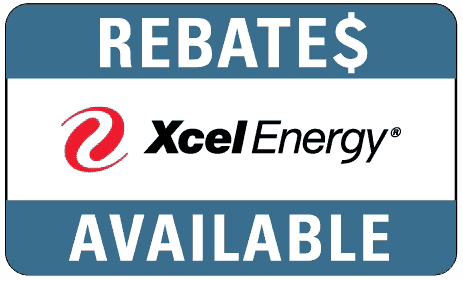
For 2025, Xcel Energy tripled its rebate amounts to encourage more homeowners to switch to efficient electric heat pumps. The exact rebate you can get depends on the type of heat pump you install and its efficiency.
Here are the current rebates available for Colorado residents in Xcel’s program:
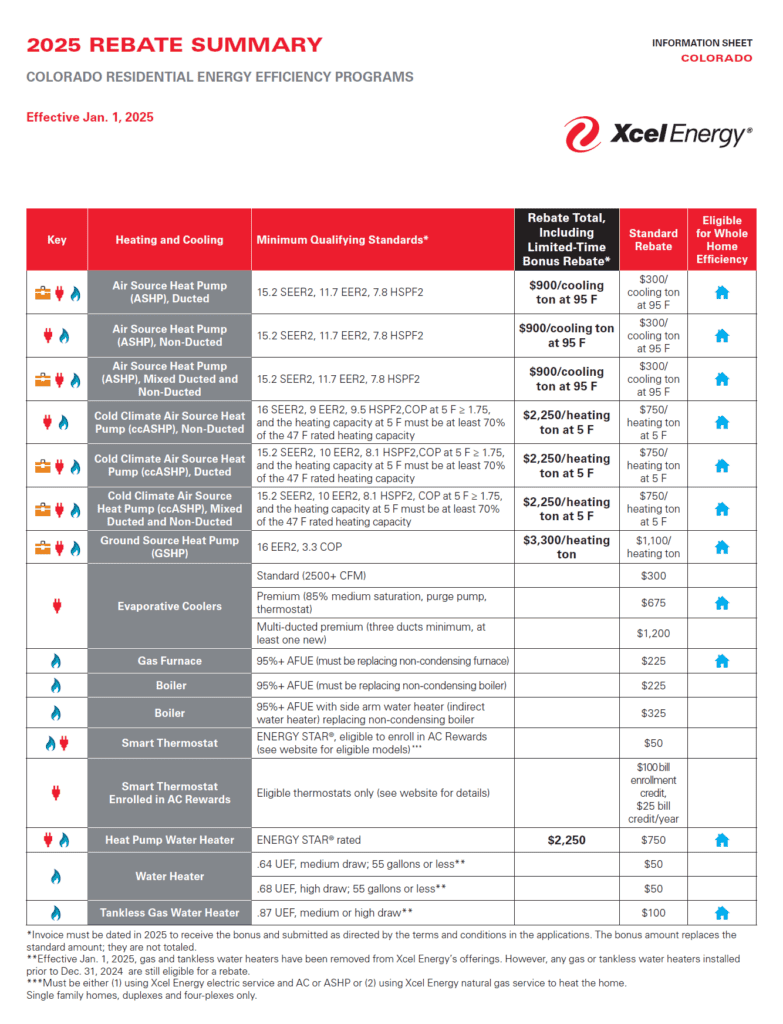
These rebate amounts are significantly higher in 2025 than prior years. Xcel boosted the incentives as part of Colorado’s clean energy initiatives (the Clean Heat Plan) to help more homeowners go green. Importantly, these rebates won’t last forever – Xcel expects the 2025 program to run ~8–12 months, but it can change or end at any time. That means if you’re interested, it’s smart to take advantage of the rebate sooner rather than later.
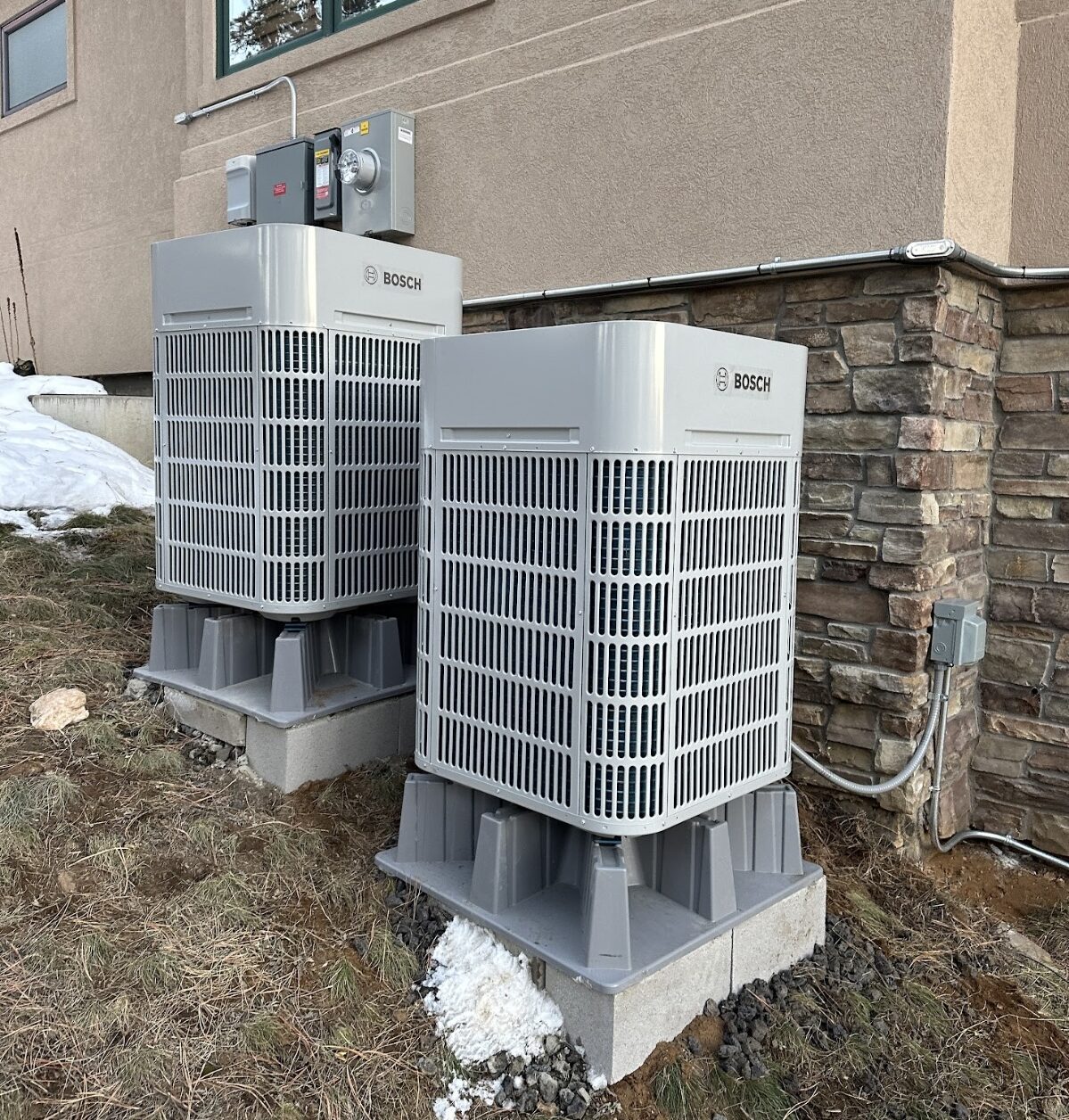
You need to meet Xcel’s eligibility rules and installation requirements. Here’s what you need to get an Xcel heat pump rebate in Colorado:
The rebates are available to Colorado residents who have Xcel Energy service – either electricity or natural gas, or both. You qualify if Xcel supplies your home’s electricity (and you have an existing AC or heat pump system) or if Xcel supplies your home’s natural gas for heating. In other words, most Xcel account holders can be eligible, whether you currently heat with Xcel gas or cool with Xcel electric service.
Rebates apply to single-family homes, duplexes, triplexes, or four-plexes. Larger multi-family buildings do not qualify under this residential program
The new heat pump system must meet Xcel’s efficiency standards (see the minimum SEER2, EER2, HSPF2/COP ratings listed above). Your HVAC contractor can help ensure the unit you select is on Xcel’s approved list. UniColorado is a top heat pump rebate producing contractor.
Xcel requires that a qualified, Xcel-registered contractor install the equipment and handle the rebate paperwork. Homeowners cannot apply for these rebates on their own – the application must be submitted by the installing contractor who is enrolled in Xcel’s rebate program. (This ensures the system is put in correctly and meets all criteria.)
The contractor will need to perform a quality installation (e.g. proper sizing, refrigerant charge) and provide proof of the equipment’s specifications, along with a detailed invoice, to get the rebate approved. As long as you hire a reputable HVAC contractor who is familiar with Xcel’s rebate process (like UniColorado), they will take care of these technical requirements for you.
If you meet these eligibility points, you stand to save a lot. Many homeowners are seeing $5,000–$10,000 or more in total rebates on a typical heat pump installation when all incentives are combined. The rebate amount scales with the size/capacity of your system – larger heat pumps (in tonnage) yield larger rebates, since Xcel pays per ton of capacity. Next, we’ll cover how you actually receive the rebate and what the process looks like.
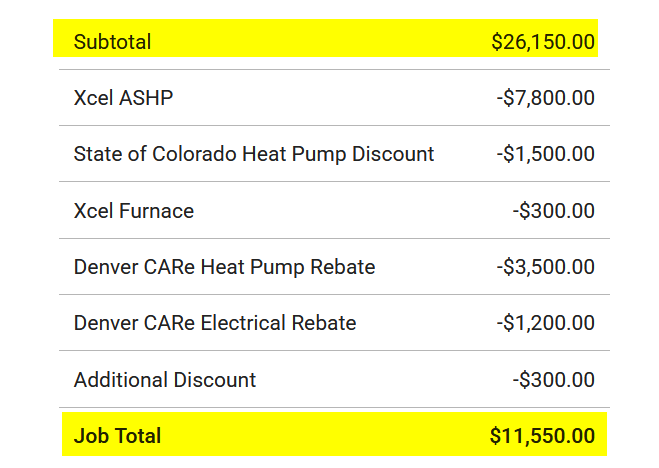
One great thing about Xcel’s rebate program is that it’s fairly hands-off for the homeowner. You do not need to fill out confusing forms or mail anything yourself. Instead, your participating HVAC contractor will handle the rebate application and make sure you get your savings. Here’s how the process works:
When getting quotes for a heat pump, confirm the contractor is an Xcel Energy rebate partner. They should help you select a qualifying heat pump model and inform you of the expected rebate amount. (For example, UniColorado provides an on-the-spot estimate of your rebate and includes it as a line-item discount on your proposal.)
The contractor installs the system to meet Xcel’s quality standards. Make sure the old equipment (if any) is properly decommissioned, as Xcel may ask for proof of replacement.
After installation, the contractor will gather all necessary documentation (equipment info, serial numbers, efficiency ratings, your Xcel account details, etc.) and submit the rebate claim to Xcel Energy on your behalf. Homeowners cannot apply directly – it must come from the installing contractor, who essentially “assigns” the rebate to either you or themselves (more on that next).
In most cases, HVAC contractors put the rebate responsibility—and the waiting period—on the homeowner. This means you’d typically pay the full installation cost upfront and then wait around 6–8 weeks (or longer, depending on Xcel Energy’s processing timelines) to receive your rebate check.
At UniColorado, we believe that’s unfair to homeowners. Our approach is different: we handle the entire rebate process and immediately apply your rebate as an upfront discount, reducing your out-of-pocket expenses right away. This means you don’t have to carry the financial risk or uncertainty of waiting for your rebate—UniColorado takes care of that for you.
Pro tip: It’s wise to verify with your contractor how the rebate will be applied. Most reputable Xcel partners, like UniColorado, handle everything end-to-end and simply give you the savings upfront (deducting the rebate amount on your invoice). This makes the upgrade more affordable immediately. If you’re a landlord installing a heat pump in a rental property, you can have the rebate assigned so that the property owner receives the benefit (as long as the owner’s name is on the Xcel account). Just coordinate with your contractor during the application.
Finally, remember that rebate funding is first-come, first-served. Even though the 2025 rebates are large, Xcel could modify or discontinue them if funds run low or policies change. To avoid missing out, plan your project earlier in the year and get your rebate application in while the program is active. Xcel explicitly advises acting promptly because there’s no guarantee these elevated rebate levels will be available beyond 2025
Xcel’s heat pump rebate is just one piece of the savings puzzle. Colorado homeowners in 2025 can stack multiple incentives – meaning you might qualify for additional rebates or credits on top of Xcel’s standard rebate, mainly the whole home efficiency program. Here are some tips to maximize your total savings:
If you plan a comprehensive energy upgrade, Xcel will reward you with extra rebate money. Under the Whole Home Efficiency program, installing three or more qualifying efficiency improvements within two years earns you a 25% bonus rebate on all the standard rebates. For example, if you install a heat pump (rebate), plus add insulation and a smart thermostat (each with their own rebates), Xcel will later give you an extra 25% of each rebate’s value as a one-time bonus. This encourages tackling multiple projects for a more efficient home. (You must use participating contractors and submit through the Whole Home program to get the bonus.)
Separately from the above, Xcel is offering a limited-time $600 bonus if you install qualifying insulation and air sealing within 6 months of your heat pump installation. Essentially, if you upgrade your home’s insulation around the same time as adding a heat pump, Xcel throws in an extra $600 rebate (on top of the regular insulation rebate and heat pump rebate). This is meant to boost your home’s overall efficiency – pairing a tighter, well-insulated home with a new heat pump means maximum energy savings.
Yes – you can combine Xcel’s rebate with other programs outside of Xcel. For instance, if you live in Denver or Boulder County, there are local government rebates (Denver’s Climate Action Rebate and Boulder EnergySmart) that can stack with Xcel’s incentive if you meet those criteria. Moreover, the federal government offers a 30% tax credit (up to $2,000) for installing a heat pump, which you can claim when you file your taxes, in addition to getting the Xcel rebate now. These combinations can dramatically lower your net cost. Many Colorado homeowners are layering city, state, and federal programs on top of Xcel’s rebate – some high-efficiency projects are seeing over $10,000 in total incentives when all sources are utilized.
Always check the latest rules for each program, as availability and requirements can change. If this sounds overwhelming, don’t worry – experienced contractors will help identify and coordinate all eligible rebates for you. At the end of the day, these incentives are there to make upgrading to a heat pump an easy decision. By tapping into Xcel’s rebates (and more), you’ll not only save big upfront but also enjoy lower energy bills for years to come, all while reducing your carbon footprint.
We’ve been designing and installing heat pump systems in Colorado for over a decade—long before they became popular. Unlike many contractors who place rebate risks and waiting periods on homeowners, we immediately apply your Xcel rebate as an upfront discount, saving you money from day one.
With UniColorado, you get the peace of mind that comes from thousands of successful heat pump installations combined with hassle-free, upfront rebate savings.
Xcel Energy rebates in 2025 are up to $2,250 per heating ton for cold-climate heat pumps, and $900 per cooling ton for standard heat pumps or mini-splits.
Colorado homeowners with active Xcel Energy gas or electric service qualify, including existing homes, rentals, and new construction. Must be 1-4 units. Larger multi-family does not qualify for regular residential rebates.
Rebates require heat pumps rated at least 15.2 SEER2, 11.7 EER2, and 7.8 HSPF2. Cold-climate models must also achieve a COP of at least 1.75 at 5°F.
No, homeowners cannot apply directly. Your HVAC contractor must submit the rebate application to Xcel Energy for you.
Yes, rebates require installation by an HVAC contractor approved by Xcel Energy.
Yes, rebates require installation by an HVAC contractor approved by Xcel Energy.
Most contractors make homeowners wait for the rebate check. At UniColorado, we provide the rebate upfront as an immediate discount.
Yes, you can stack Xcel Energy’s rebates with the federal heat pump tax credit (up to $2,000) and local Colorado rebates for maximum savings.
Xcel’s Whole Home Efficiency bonus adds 25% extra rebate if you install three or more qualifying energy upgrades within two years, starting with an energy audit.
Yes, an energy audit from an approved contractor is required to qualify for Xcel’s Whole Home Efficiency bonus rebate.
Yes, Xcel offers a limited-time $600 bonus rebate if you install insulation and air sealing within 6 months of your heat pump installation (2025 only).
Xcel’s 2025 rebates are budget-limited, first-come, first-served, and are expected to last through most of the year, but they could end sooner.
Yes, rental homes, duplexes, triplexes, and four-plexes qualify for Xcel’s residential heat pump rebates if the owner holds the Xcel account.
Xcel’s rebate amount is based on your heat pump’s size (capacity). “Per ton” means per 12,000 BTUs/hour capacity—the larger the system, the bigger the rebate.
